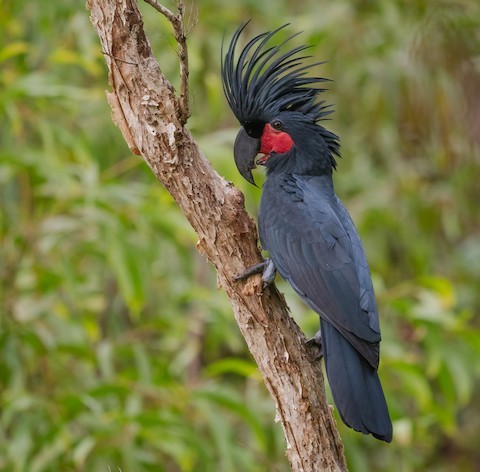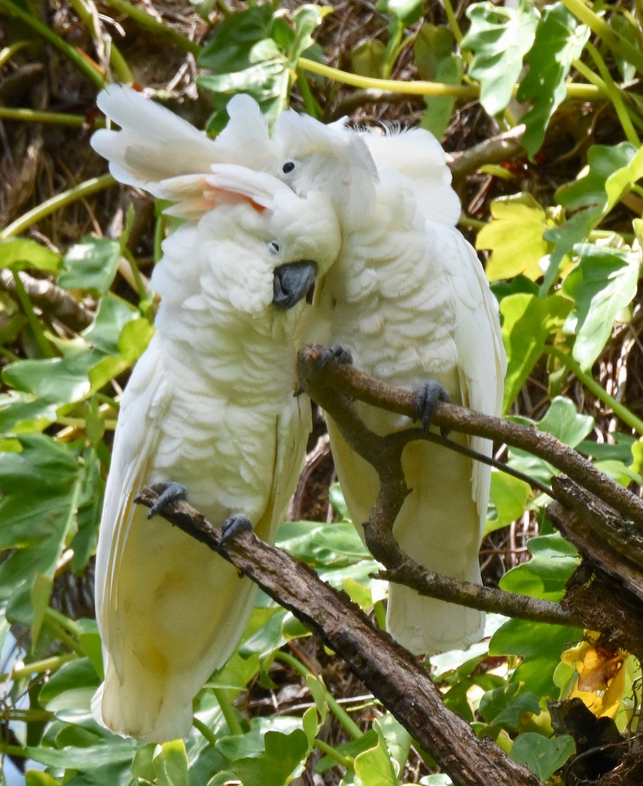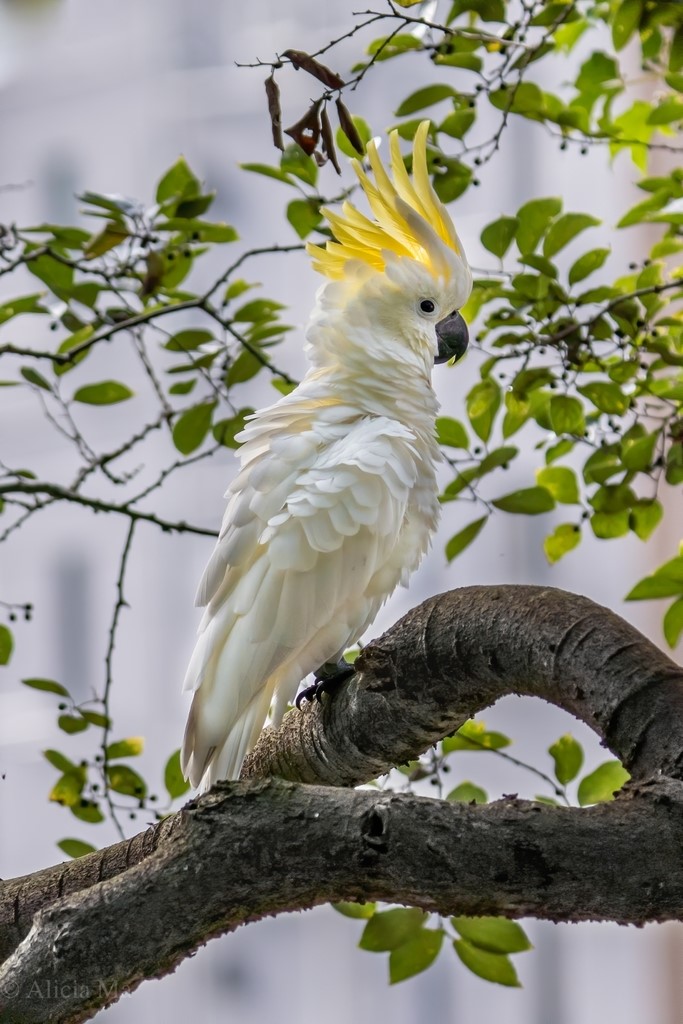Cacatuidae: Cockatoos

Palm Cockatoo with its crest raised. © Barry Deacon
The cockatoos are a small Australasian family of parrots, several of which are widely kept in captivity. They differ most noticeably from other parrots in having predominantly white, black, gray, or pink plumage and tall, luxuriant crests which they often raise expressively. Some species also have apparently large saucer eyes—an illusion caused by white orbital skin which humans perceive as the surface of a large eyeball.
Like parrots of other families, cockatoos are intelligent and capable of mimicking human speech, and bond readily with human companions. They also share the characteristic parrot bill, which is stout, deep-based, hooked, roughly semi-circular when closed. and phenomenally strong and versatile. Cockatoo bills are larger and stronger on average than the bills of other parrots—the extraordinary Palm Cockatoo (Probosciger aterrimus) has a greatly exaggerated upper mandible and one of the world’s most powerful bills.
Traditionally, all parrots were usually grouped together as a single family, but recent research into their evolutionary history has led to the recognition of four or five families. The Cacatuidae are recognized as a distinct branch primarily due to internal anatomical differences, and because genetic markers show that they represent an ancient lineage, having diverged from all other parrots tens of millions of years ago.
Several cockatoo populations are subject to intense persecution due to their value in the illicit cagebird trade. Trapping has driven the Philippine endemic Red-vented Cockatoo (Cacatua haematuropygia) close to extinction as a wild species, and several of its Indonesian relatives—the Yellow-crested (C. sulphurea), Salmon-crested (C. moluccensis), and White (C. alba) cockatoos, and the Tanimbar Corella (C. goffiniana)—are in various stages of endangerment.
Released captive cockatoos have formed feral flocks in urban areas, including Hong Kong, Honolulu, San Juan (Puerto Rico), Singapore, and a few parts of Taiwan. These flocks persist in part due to the longevity of individuals, but also in some cases through breeding that could lead to self-sustaining populations. Although invasive exotic species are generally disfavored, there is a conservation argument for making exceptions in some cases—such as the Salmon-crested Cockatoos in Honolulu and White Cockatoos in San Juan, Puerto Rico, which do not compete with any of the few remaining island endemic bird species.

Salmon-crested Cockatoo (left) preened by what appears to be a White Cockatoo—apparently a mixed-species mated pair. (Lyon Arboretum, Honolulu, Hawaii.) © Walter Oshiro
Identification
Several white cockatoos of the genus Cacatua are extremely similar, with inconspicuous differences in plumage and bare parts coloration. The potentially confusing species do not occur together naturally, but several of them coexist in feral flocks: e.g., in Honolulu, Singapore, and Taiwan. Accurate identification is potentially significant in these areas to distinguish the several endangered species from their commoner relative, the Sulphur-crested Cockatoo (C. galerita). Adding to the potential for confusion, hybridization between similar species has been documented in some feral flocks. (For a detailed comparison of the five species or forms in this complex, see Distinguishing Features: Identification of Yellow-crested Cockatoos.)
Within Australia, the black-cockatoo group presents unusual identification challenges, as closely related species pairs occur together, and distinguishing them entails close study of key details. In particular, Carnaby’s and Baudin’s Black-Cockatoos (Calyptorhynchus latirostris and baudinii) have almost entirely overlapping distributions and are nearly identical except for the lengths of their upper mandibles—their vocalizations and habitat also differ.

The Yellow-crested Cockatoo is just one of five white cockatoo species or forms that have yellow crests. (Hong Kong; September 14, 2020.) © Alicia Ma
Taxonomy
The species-level taxonomy of the Cacatuidae is mostly settled, with 21 to 23 species recognized. The Yellow-crested Cockatoo (Cacatua sulphurea), as traditionally classified, includes a distinct form, the “Citron-crested Cockatoo” (citrinocristata), which the Handbook of the Birds of the World and BirdLife International recognized as a full species in 2021, and the Sulphur-crested Cockatoo (C. galerita), as traditionally classified, includes a distinct form, the “Triton Cockatoo” (triton), which has an ambiguous status.
There are three main clades, which might be appropriately recognized as subfamilies: (1) the Cockatiel (Nymphicus hollandicus), an atypically small, thin, long-tailed (generally parakeet-like) cockatoo species that apparently diverged from the rest many millions of years ago; (2) the five species of black-cockatoos; and (3) the typical cockatoos, which comprise the dozen-or-so white Cacatua species plus four single-species genera. Both the Cockatiel and black-cockatoo clades are endemic to Australia. The typical cockatoos are more widely distributed—across Australia, New Guinea, and northwest through the Malay Archipelago to the Philippines and east to the Solomon Islands.
Cockatiel (Nymphicus hollandicus)
Red-tailed Black-Cockatoo (Calyptorhynchus banksii)
Glossy Black-Cockatoo (Calyptorhynchus lathami)
Yellow-tailed Black-Cockatoo (Calyptorhynchus funereus)
Carnaby’s Black-Cockatoo (Calyptorhynchus latirostris)
Baudin’s Black-Cockatoo (Calyptorhynchus baudinii)
Palm Cockatoo (Probosciger aterrimus)
Gang-gang Cockatoo (Callocephalon fimbriatum)
Galah (Eolophus roseicapilla)
Major Mitchell’s Cockatoo (Lophochroa leadbeateri)
Salmon-crested Cockatoo (Cacatua moluccensis)
Blue-eyed Cockatoo (Cacatua ophthalmica)
Sulphur-crested Cockatoo (Cacatua galerita)
“Triton Cockatoo” (C. g. triton)
“Sulphur-crested Cockatoo” (C. g. galerita)
Yellow-crested Cockatoo (Cacatua sulphurea)
“Yellow-crested Cockatoo” (C. s. sulphurea)
“Citron-crested Cockatoo” (C. s. citrinocristata)
Red-vented Cockatoo (Cacatua haematuropygia)
Tanimbar Corella (Cacatua goffiniana)
Solomons Corella (Cacatua ducorpsii)
Long-billed Corella (Cacatua tenuirostris)
Western Corella (Cacatua pastinator)
Little Corella (Cacatua sanguinea)
References
Boyd, J.H., 2018. Taxonomy in Flux: Basal Australaves: Cariamiformes, Falconiformes, and Psittaciformes. http://jboyd.net/Taxo/List12.html. (Posted July 6, 2018. Accessed August 2, 2021.)
Cameron, M. 2007. Cockatoos. CSIRO Publishing, Collingwood, Victoria, Australia.
Collar, N.J., and S.J. Marsden. 2014. The subspecies of Yellow-crested Cockatoo Cacatua sulphurea. Forktail 30:23-27.
Forshaw, J.M. 2010. Parrots of the World. Princeton University Press.
Juniper, T., and M. Parr. 1998. Parrots: A Guide to Parrots of the World. Yale University Press.
Mulawki, E.J. 2014. The Cockatoos: A Complete Guide to the 21 Species. McFarland & Co., Jefferson, N.C.
Roberson, D. 2020. Bird Families of the World: Cockatoos, Cacatuidae, http://creagrus.home.montereybay.com/cockatoos.html. (Posted October 2, 2020. Accessed August 2, 2021.)
Text © Russell Fraker / September 25, 2021